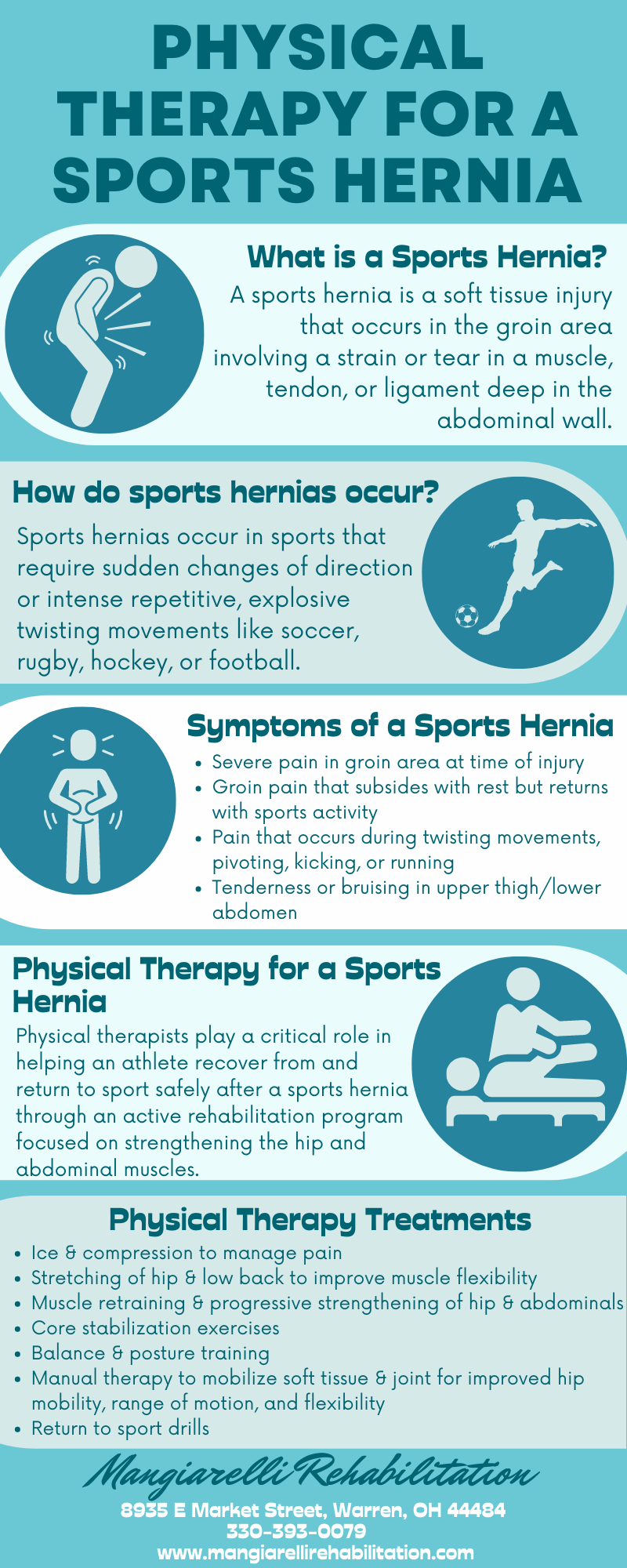Physical Therapy for a Sports Hernia
A sports hernia is a soft tissue injury that occurs in the groin, pelvis, or lower abdomen involving a strain or tear in a muscle, tendon, or ligament deep in the abdominal wall. Injury often occurs at the base of the abdominal muscles, such as the rectus abdominis and oblique muscles. In this area, the muscles have formed down to a thin sheath (a tendon) and if weakness is present in this area, excessive force from twisting or kicking can result in a tear. Sports hernias specifically affect the oblique muscles in the lower abdomen, the tendons that attach the obliques to the pubic bone, and the tendons that attach the thigh muscles to the pubic bone.
Sports hernias occur in sports that require sudden changes of direction or intense repetitive, explosive twisting movements like soccer, rugby, hockey, or football. Sports hernias can result from forceful repetitive hip movements (twisting, kicking, jumping, cutting, or slicing), vigorous unsafe abdominal and hip exercises, weakness in the abdominal muscles, lack of proper sports conditioning, or imbalances in hip and abdominal muscle strength. Men are more likely to experience a sports hernia than women due to differences in pelvic anatomy and sports hernias more commonly occur in male athletes in their late 20s.
Common symptoms of a sports hernia include severe pain in the groin area at the time of injury, groin pain that subsides with rest but returns with sports activity, pain that occurs during twisting movements, pivoting, kicking, or running, and tenderness or bruising in the upper thigh or lower abdomen. Pain may also radiate down into the inner thigh, testes, and rectum.
Physical therapists play a critical role in helping an athlete recover from and return to sport safely after a sports hernia through an active rehabilitation program focused on strengthening the hip and abdominal muscles. The therapist first conducts a comprehensive evaluation to assess the athlete’s strength, range of motion, and balance to find areas of limitation and design a customized treatment program.
During early rehabilitation, the focus is to reduce pain and promote healing of the damaged tissue using ice and heat modalities and therapeutic massage. Manual therapy may also be used to initiate passive movement and range of motion in the injured area. As therapy progresses, the athlete begins a gradual re-strengthening program targeting the hip, pelvic, and abdominal muscles before moving on to functional training and return to sport training.
A 2019 study showed that an active rehabilitation program involving balance and core-strengthening exercises helped athletes return to full activity faster than a conventional rehabilitation plan. Active rehabilitation, which took place over an 8-week span, involved core stabilization exercises, strengthening of the hip adductors and abdominal muscles, and balance and posture training. Athletes in the study who underwent active rehabilitation had decreased pain and a higher rate of return to sport than those who received conventional treatment.
Physical therapy treatment for a sports hernia can include:
Pain management using ice and compression
Stretching of the hip and low back to improve muscle flexibility
Muscle retraining and progressive strengthening of the hip and abdominal muscles
Core stabilization exercises
Balance and posture retraining
Manual therapy to mobilize soft tissue and joint for improved hip mobility, range of motion, and flexibility
Functional return to sport drills
If sports hernia pain persists two to six months after non-surgical treatment or the athlete has had a previous sports hernia tear, surgery may be needed. Ninety percent of surgeries fix a sports hernia successfully. Surgery involves repairing the torn tissue through a small open incision in the upper part of the groin. The acquired adductor contracture is released, and the lower rectus muscles are reattached to the pelvis, restoring normal biomechanical movement of the pelvis. Following surgery, post-surgical physical therapy is essential to regain strength and stamina in the abdominal area. An athlete can expect to return to sport after surgery and physical therapy within 6-12 weeks post-surgery.
To prevent sports hernias from occurring, athletes should concentrate on core stabilization and strengthening as well as exercises to improve flexibility and minimize strain across the lower abdominal area where sports hernias most often occur. Targeted strengthening of the hip and gluteal muscles is essential as well to improve pelvic stability.
Are you experiencing symptoms of a sports hernia? Work with a physical therapist to address these symptoms and regain function and strength in the abdominal area for a safe return to competition.
